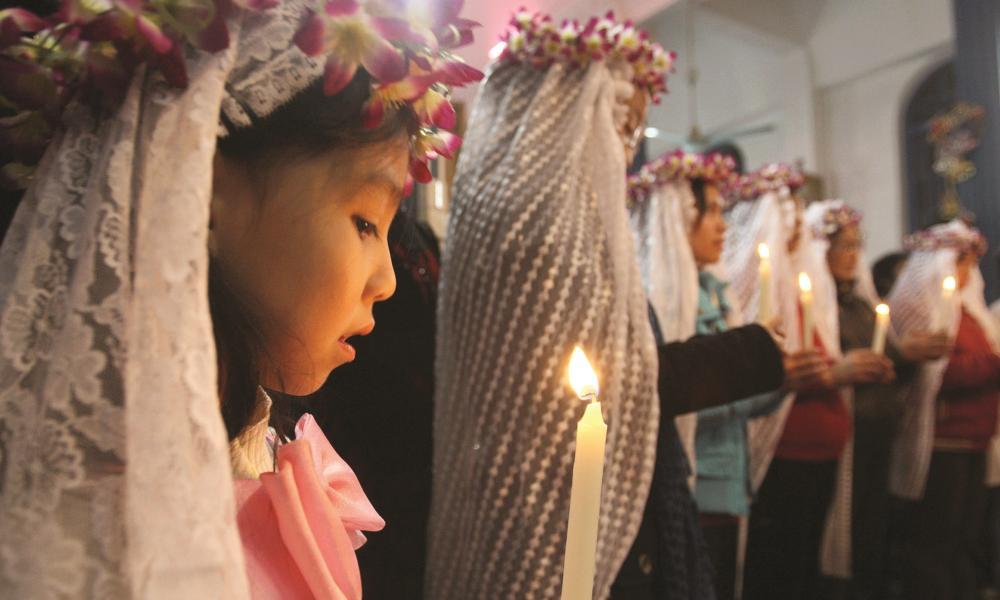
What Can We Learn From the Universal Church?
Q: The American church is sometimes said to see its own issues as universal. What can we learn from looking at the way the church functions in other countries?
A: First of all, we should not use the term “American church.” Pope John Paul II mentioned that there is no such thing as a white church or a black church or an American church or a European church. It is all the Catholic Church. It is better to speak of the church in the United States or the church in Europe. But, having said that, another beautiful thing Pope John Paul said when he came to the United States was that the church in the United States is, by its very nature and composition, Catholic. Because catholic means universal. More than in any nation on earth, the components of those who make up the church in the United States come from all these backgrounds, ethnic groups and nationalities. It’s like the Book of Revelation says, “From every tribe and nation and tongue on earth …” So this is a beautiful advantage to begin with. We are a people who are naturally catholic, naturally universal.
But this is also a challenge to us, a challenge when we think of immigration and of generosity in admitting people to our shores. We have come from every nation on earth and other people would like to come in and be part of this. By our nature here, we are challenged to generosity and understanding of other people’s plights.
In the past, the church in the United States has shown extraordinary sense of generosity. The immigrants came to these shores and built beautiful churches and schools. They did so much and they also helped the countries they had left. So the Catholics of the United States, after the world wars, contributed to rebuilding Europe. And right now, we have collections for Eastern and Central Europe and for missions. When Pope John Paul II came to the United States for his first visit in 1979, one of the things he said was that this was an hour of solemn gratitude for him to thank the people of this country for all they had done, so generously, from the beginning until now.
So that is part of the reality. And sometimes we need to be challenged more. Sometimes, in our generosity, we forget the full dimension of the needs of the world. The whole world, for many years now, has been forgetting the needs of the people of the Sudan and Darfur. Those are just a couple of examples.
Just as the church in the United States has certain characteristics, when you go to other countries, you will see how they actuate their Christianity in some particular way. There is something special about each people. When you go to Bolivia, Croatia, Japan or China, there is something special and unique about each of those peoples.
The church in the United States has a great deal to offer and a great deal to learn.
Words of wisdom – can you complete the proverb?
The Sacred Scriptures teach us “to get wisdom, to get understanding!” (Proverbs 4:5) Now it is time to put yourself to the test to see how far along you are in this quest by completing this proverb. Remember, no peeking into your Bible!
For all were by nature foolish who were in ignorance of God, and who from the good things seen _________
a. were not unaware that their race was wicked and their malice ingrained.
b. no longer safeguarded either lives or pure wedlock.
c. did not succeed in knowing him who is, and from studying the works did not discern the artisan.
(Answer: c – Wis 13:1)
Are you a heretic?
A theology professor once remarked that there were no new heresies, just old ones repackaged. To test the truth of this statement, consider this recent real-life scenario and see if you can name the error involved:
I decide what’s best for me!
A woman is defending her decision to begin co-habitating with her boyfriend. Her friend advises against the decision on religious and moral grounds. Sensing the first woman is unmoved by her appeal to religion and morality, the second woman introduces hard, scientific data that further raises red flags over the decision. Finally, the first woman shakes off the objections of the second woman declaring, “I don’t care what you or anyone else says about it, I feel very strongly that this is the best thing for me so I believe it is.”
What is at stake? The reasonableness of Christianity is declared irrelevant in decision-making; subjectivism and relativism gain prominence over objective truth.
What is the truth? This position is common in today’s culture and has its roots in the 1960s and the authenticity movement. According to this doctrine, the intensity of feeling alone determines the truth, regardless of facts and evidence to the contrary. The problem is that feelings change and intensity fades. This view, in essence, leads to the irrelevance of the God of Christianity. With no ultimate criteria to frame our decision-making, fragmentation, division and even tyranny by so-called reformers become possible. Such a subjective and relative approach to decision-making eliminates from consideration the rationality and objectivity of not only common sense and experience, but of the common good.
Church of the month
The power and vitality of the Christian faith have long inspired tremendous works of art on the part of believers. One has only to consider the beauty of many of our principal churches to realize the transcendent beauty of our faith. For example, consider:
Basilica of the National Shrine of the Immaculate Conception
The Basilica of the National Shrine of the Immaculate Conception is located in Washington, D.C., and honors the Blessed Virgin Mary as Our Lady of the Immaculate Conception, the patroness of the United States. It is the largest Catholic church in America and one of the largest religious structures in the world. Millions of pilgrims visit the basilica each year. It is designated as a national historic landmark.
The basilica does not have its own parish community, but it serves the adjacent university, the United States Conference of Catholic Bishops (located down the street) and hosts numerous Masses for organizations of the church from across the United States. It houses dozens of chapels honoring Mary and reflecting the origins of the Catholic immigrants and religious orders whose generosity erected them.
The exterior of the basilica is 459 feet long, 240 feet wide, and 237 feet tall to the top of the cross on the dome. The diameter of the main (Trinity) dome of the basilica is only seven feet shorter than that of the dome of the United States Capitol.
Origin:
In 1792, John Carroll, the bishop of Baltimore, consecrated the newly created United States under the protection of the Blessed Virgin Mary under the title of the Immaculate Conception. In 1847, Pope Pius IX proclaimed The Immaculate Conception as the patronness of the U.S. Then Bishop Thomas Joseph Shahan proposed the construction of the national shrine, taking his appeal to Pope Pius X in 1913.
After receiving a land donation from the Catholic University of America, Shahan published the Salve Regina, a newsletter meant to stir enthusiasm for his project. He wrote that the shrine would be a “monument of love and gratitude, a great hymn in stone as perfect as the art of man can make it and as holy as the intentions of its builders could wish it to be.” His newsletter was circulated to dioceses throughout the country and financial donations began to pour in. Church construction began in 1920 and the building opened in 1959. Even now, the basilica is considered to be incomplete.
Notable features:
• The Founder’s Chapel – the chapel within the shrine containing the tomb of Bishop Thomas Joseph Shahan.
• The Papal Tiara of Pope Paul VI – the crypt has displayed this tiara since 1968.



